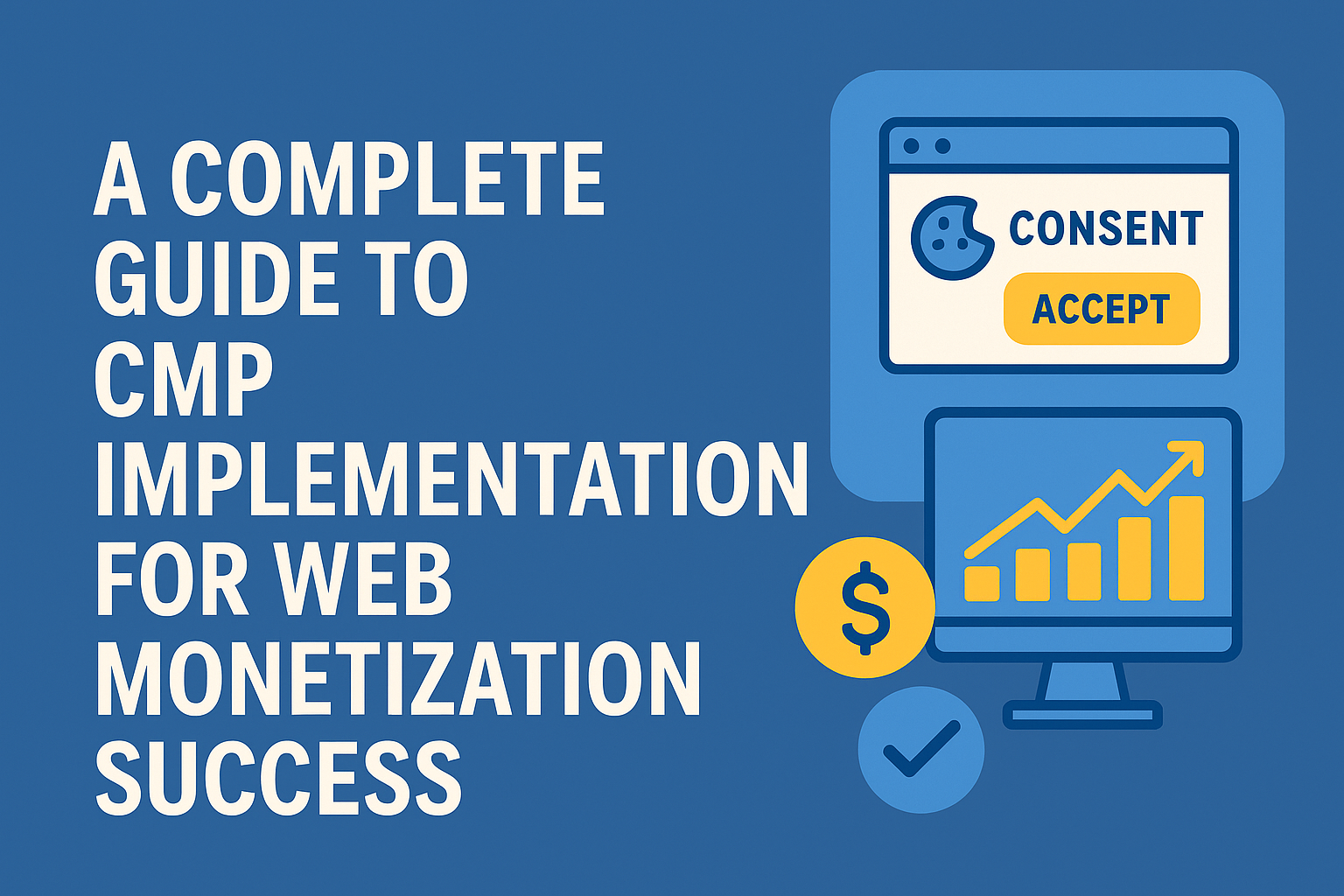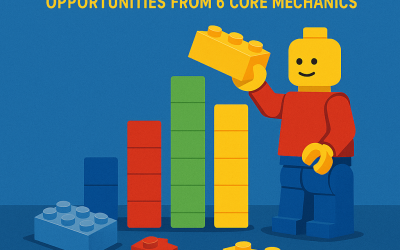A Complete Guide to CMP Implementation for Web Monetization Success
If you’re running a gaming website, mobile app, or Unity-based game, you’ve probably heard the term “CMP” thrown around in developer circles. But what exactly is a Consent Management Platform, and why should you care about implementing one? On this post, A Complete Guide to CMP Web Monetization Success, we will discuss Consent and Privacy!
Here’s the thing: a CMP isn’t just another compliance checkbox you need to tick. It’s actually a strategic tool that can enhance your monetization performance while keeping you on the right side of privacy laws. Think of it as your gateway to maintaining healthy ad revenue in an increasingly privacy-conscious world.
Contents
- 1 What Exactly Is a Consent Management Platform?
- 2 Why CMPs Are Your Monetization Best Friend
- 3 Understanding the Privacy Landscape
- 4 Choosing the Right CMP for Your Needs
- 5 Implementation: Making It Work on Your Platform
- 6 The Technical Magic: Consent Signals and Ad Partners
- 7 Testing: Because Nobody Wants Surprises
- 8 Optimization: Turning Compliance into Revenue
- 9 Staying Current: The Ongoing Journey
- 10 Common Mistakes That Cost Money
- 11 The Rewarded Video Connection
- 12 AppLixir Rewarded Video Ad
What Exactly Is a Consent Management Platform?
A Consent Management Platform is essentially your digital privacy concierge. It’s the tool that handles all the heavy lifting when it comes to collecting, managing, and documenting user consent for data processing. Instead of you having to figure out the complex legal requirements for every country your users might be in, the CMP acts as a smart intermediary between privacy regulations and your monetization platforms like Google AdMob or AppLixir.
The beauty of a well-implemented CMP is that it works behind the scenes. Your users get a clear, transparent choice about their data, and you get to maintain your advertising revenue streams without constantly worrying about compliance issues.
Why CMPs Are Your Monetization Best Friend
Following on A Complete Guide to CMP Web Monetization Success. you might be thinking, “Great, another tool I need to learn and implement.” But here’s where it gets interesting—CMPs actually protect and often improve your bottom line. When you’re compliant with privacy regulations, you avoid the nightmare scenario of blocked ads or reduced demand from programmatic sources.
More importantly, when users trust your platform enough to give consent, you’re likely to see better performance from your rewarded video ads and higher CPMs overall. It’s a win-win situation that builds long-term sustainability into your monetization strategy.
If you’re in the gaming space and rely heavily on rewarded video ads, failing to implement a proper CMP could mean watching your revenue streams dry up as demand partners become more selective about compliance.
Understanding the Privacy Landscape
Before diving into implementation, you need to understand which privacy laws actually affect your business. The big players you’ve probably heard about are GDPR in Europe, which requires explicit consent before collecting personal data, and CCPA in California, which gives users the right to opt out of data selling.
But the privacy landscape is global now. Brazil has LGPD, South Africa has POPIA, and new regulations are popping up regularly. The good news is that most quality CMPs are built to handle multiple frameworks, especially if they support IAB TCF 2.2 (Transparency & Consent Framework), which is becoming the global standard.
Choosing the Right CMP for Your Needs
Not all CMPs are created equal, and this is where your monetization strategy really matters. If you’re primarily focused on web monetization, you’ll want different features than someone running a mobile app empire.
Some of the most reliable players in the space include OneTrust, Quantcast Choice, Sourcepoint, and Usercentrics. If you’re already using AppLixir for rewarded video implementation, they also offer CMP features that integrate seamlessly with their advertising solutions.
The key is finding a CMP that plays nicely with your existing tech stack. If you’re using Google AdMob for rewarded ads or participating in Google’s Ad Exchange, make sure your chosen CMP is on Google’s Certified CMPs list. This isn’t just a nice-to-have—it’s essential for maintaining your ad inventory quality.
When evaluating options, look for compatibility with IAB TCF 2.2, solid support for both mobile SDK and web integration, real-time reporting capabilities, and the ability to A/B test different consent dialogs. The last point is crucial because the way you present consent options can significantly impact your opt-in rates.
Implementation: Making It Work on Your Platform
For Website Owners
Getting started with web implementation is relatively straightforward. You’ll need to add the CMP JavaScript code to the head section of your site—this script handles the consent pop-up and manages communication with ad vendors.
The real magic happens in the configuration phase. You’ll use your CMP dashboard to define purposes like ad personalization and analytics, then specify which vendors you work with. Most modern CMPs can automatically block third-party scripts until users grant consent, which is exactly what you want for compliance.
Don’t overlook the importance of customizing your consent UI. This isn’t just about making it look pretty—though that helps. The colors, language, and overall user experience design can dramatically impact your consent opt-in rates. A well-designed consent flow feels natural and trustworthy, while a clunky one can send users running.
For Mobile App Developers
Mobile implementation requires a bit more technical work, but the principles are similar. You’ll install your CMP’s SDK and integrate the consent dialog into your app’s onboarding process or before loading ads.
The critical piece here is syncing with your ad SDKs. You need to pass the consent string to networks like AdMob, AppLixir, or Unity Ads so they know how to handle each user’s data preferences. Don’t forget to persist consent across sessions using shared preferences or your platform’s secure storage mechanisms—nobody wants to ask for consent every time a user opens the app.
The Technical Magic: Consent Signals and Ad Partners
Following on A Complete Guide to CMP Web Monetization Success, Here’s where things get interesting from a technical standpoint. When a user grants consent, your CMP generates what’s called a TC string. This string is like a digital passport that travels with ad requests, telling demand partners exactly what they can and can’t do with that user’s data.
This system allows you to maintain your CPM and eCPM values by ensuring you’re sending compliant inventory to programmatic buyers. Without proper consent signals, many demand partners simply won’t bid on your inventory, which directly impacts your revenue.
If you’re running rewarded video ads—whether for websites or Unity monetization—your CMP integration becomes even more critical. The CMP needs to trigger before your rewarded ad SDK loads, support prebid or header bidding setups, and share consent information with mediation platforms.
Testing: Because Nobody Wants Surprises
Never deploy a CMP without thorough testing. This isn’t the place to “move fast and break things.” Use tools like Google’s Consent Mode Debug Tool, your CMP vendor’s testing tools, or third-party scanners like Tag Inspector.
Your testing checklist should cover the basics: Is the banner visible on first load? Are cookies properly blocked before consent? Is consent information correctly passed to ad SDKs and vendors? Can users easily revoke or change their consent later?
Pay special attention to how your incentivized ads and rewarded video SDKs behave under different consent scenarios. You want to ensure a smooth user experience regardless of the user’s privacy choices.
Optimization: Turning Compliance into Revenue
Once your CMP is live, it becomes a revenue-impacting tool that deserves ongoing attention. You’ll want to track key metrics like consent rate (the percentage of users granting permission), bounce rate changes, CPM performance comparisons, and ad fill rate variations.
This is where the real optimization opportunities lie. A/B testing different banner styles can reveal surprising insights about user preferences. Sometimes a “soft” opt-in format works better than a hard choice. Adjusting your wording to emphasize benefits—like explaining that ads support free content—can improve consent rates.
Don’t forget about localization. If you have a global audience, consent dialogs that work in English might fall flat in other languages or cultures. Higher consent rates directly translate to more personalized ads, which typically means better CPM, ARPDAU, and rewarded ads revenue.
Staying Current: The Ongoing Journey
Privacy regulations and ad tech standards evolve constantly. Set up a system to stay informed—whether that’s email alerts from IAB, regular check-ins with your CMP provider, or quarterly reviews of your consent settings.
Update your SDKs and CMP versions regularly, and be prepared to adapt to new laws like CPRA (California Privacy Rights Act). This isn’t a “set it and forget it” solution—it’s an ongoing part of your technical infrastructure.
Common Mistakes That Cost Money
I’ve seen plenty of implementations go wrong, and the mistakes usually fall into predictable categories. Many developers focus only on GDPR compliance and forget about CCPA, which can lock them out of the lucrative California market.
Another common issue is overly aggressive ad blocking before consent. While you need to block tracking, completely preventing ads from loading can significantly reduce revenue. The goal is surgical precision, not a sledgehammer approach.
Hard opt-in dialogs that feel pushy or confusing can drive users away entirely. Nobody wants to lose users over a consent dialog, especially when a more thoughtful approach could achieve better results.
Finally, don’t underestimate the importance of multi-language support. If you’re running a global app or website, consent dialogs in the user’s native language aren’t just nice—they’re necessary for meaningful compliance.
The Rewarded Video Connection
If rewarded video ads are part of your monetization strategy, CMPs play a particularly important role. The reward video model is built on a value exchange—users consent to watch an ad in return for in-game rewards or benefits. But even when users decline tracking, you still need a way to show non-personalized ads legally.
A well-configured CMP allows you to separate consented versus non-consented users, adjust your ad strategy dynamically, and ensure all ad calls respect privacy policies. Whether you’re monetizing Unity games, HTML5 games, or a content site, this flexibility helps you retain monetization compliance while maximizing user value.
AppLixir Rewarded Video Ad
Last but not least on A Complete Guide to CMP Web Monetization Success post, Implementing a CMP isn’t just about checking a legal compliance box—it’s a strategic investment in your platform’s long-term success. In an era of increasing privacy awareness and tightening regulations, a strong CMP setup protects your monetization strategy while building genuine user trust.
If you’re using platforms like AppLixir, AdMob, or Unity Ads, deep CMP integration isn’t optional anymore. The better your consent flows work, the higher your eCPM, ad fill rate, and overall rewarded video ads revenue will be. The privacy-first future is already here. The question isn’t whether you need a CMP—it’s whether you’ll implement one strategically or scramble to catch up later. Choose wisely, and your users (and your revenue) will thank you.



